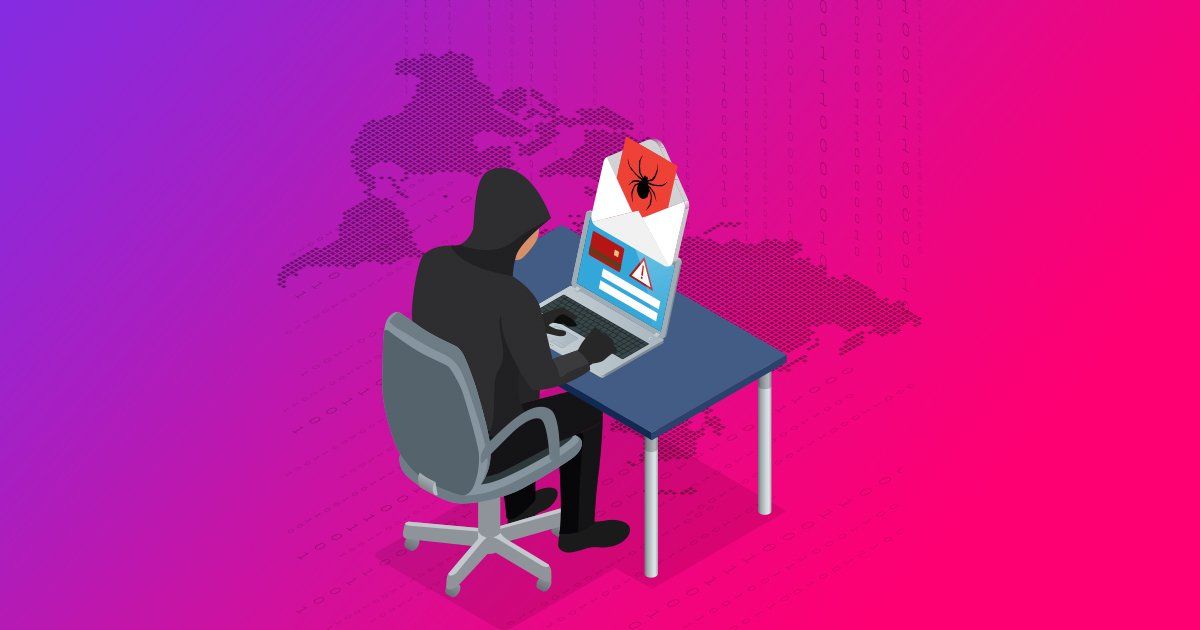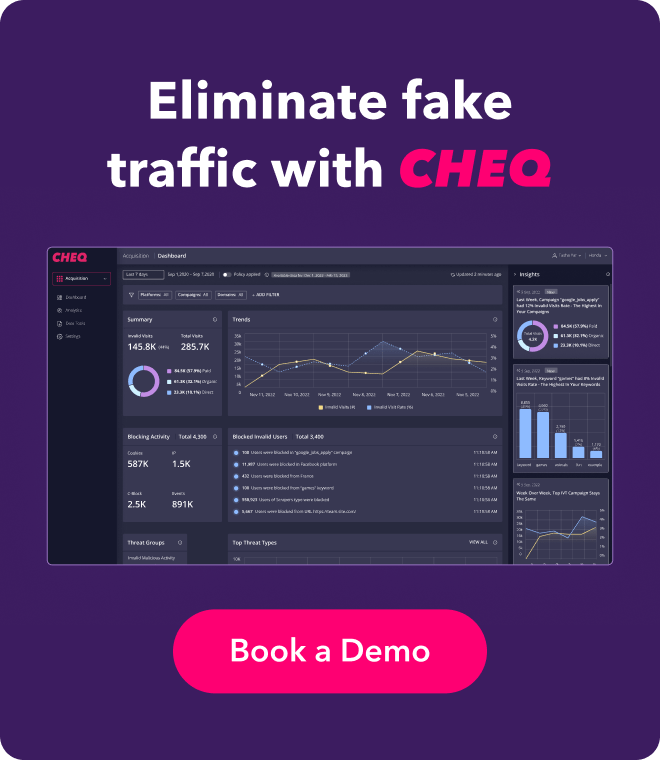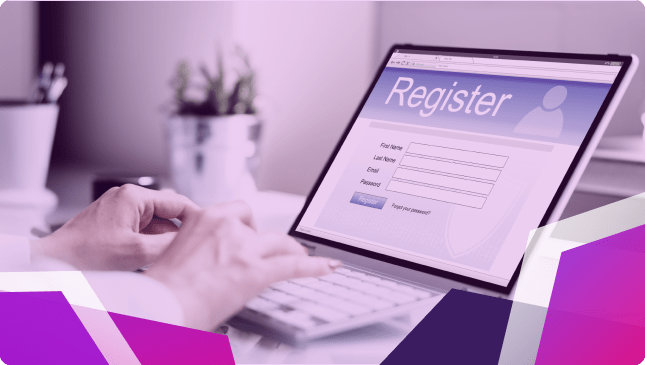Invalid Traffic & How It Impacts Marketing
Kerry Coppinger
|Cyber Risks & Threats | August 02, 2021

Invalid Traffic (IVT) is an increasingly important concern for marketers and business professionals looking to maximize the impact of their efforts. As we discover more about IVT and the specific ways it can negatively influence a customer acquisition funnel, it’s important for smart marketers to educate themselves on issues caused by Invalid Traffic and how to address them.
But what exactly is Invalid Traffic, and why is it such a problem?
Invalid Traffic is a general term used to describe users and site visitors who have no chance of converting to legitimate paying customers. Oftentimes, the first thing that people think of relating to IVT is malicious bots. However, Invalid Traffic is actually much broader and includes many types of non-legitimate traffic. Some examples are automated bots, account hijackers, users hiding behind proxy servers, competitors, click farms, JS-disabled browsers, automation tools, and anything that cannot contribute positively to your business objectives.
In fact, research shows that in almost 20 countries, at least 10% of traffic is invalid. In some areas, average invalid rates can get as high as 28%. This means that if you have 1 million annual site visitors, and an invalid rate of 10%, then 100,000 visitors are not legitimate users and have no chance of turning into legitimate customers. This can be especially concerning if valuable resources are being allocated to these users, like ad spend, email marketing, retargeting, nurture campaigns, and more.
Why are marketers suddenly becoming more concerned with IVT?
For many years, the issue of IVT has been swept under the rug by marketers as something that is only an issue for cyber security professionals, and therefore doesn’t fall into their domain. Some marketers would also previously ignore or downplay the issue of Invalid Traffic because of a few common misconceptions. Now that these misconceptions are being debunked and marketers are better understanding IVT, they are able to address the issues it causes.
1) Marketers are understanding that IVT affects nearly all websites
Whether or not malicious users are specifically targeting you, almost every website in the world experiences some level of Invalid Traffic. This is because Invalid Traffic isn’t just composed of “bad guys” and malicious users. Even the most innocent automation tools that scan the internet for content issues are frequently incorrectly labeled as real site visitors. Not to mention, there are large operations like click farms that manipulate data at a large scale. Organizations like this might not be targeting you directly, but if your website is relatively easy to find on the internet, invalid users could make their way to you.
2) Marketers finally have the tools to measure how they are impacted by IVT
Just because we are not aware of an issue doesn’t mean it doesn’t exist. Similarly, if you don’t go to the doctor, you will never get diagnosed with an illness, but that doesn’t mean you don’t have one. Leading cyber security companies are addressing this gap in knowledge through a category of technology called Customer Acquisition Security (CAS). By using a CAS platform, you can discover exactly how much of your traffic is invalid, where it’s coming from, what types of threats are most prominent to you, and even how to address these issues through monitoring and protecting your platforms.
3) Organizations are recognizing how IVT impacts various areas of their business
Virtually no marketer has a KPI on Invalid Traffic, so it’s fair to question why this should be a priority. When we address Invalid Traffic though, we are not simply removing invalid users, but also in many cases replacing them with valid ones. By optimizing your customer acquisition funnel toward real users, you are increasing the amount of traffic that has the possibility to convert. You are filling your funnel with more qualified visitors and ultimately more qualified leads. So maybe you don’t have a KPI for Invalid Traffic but if you have one for lead generation, pipeline, or revenue then examining your invalid rate is a good idea.
4) Marketers are realizing how large of an issue IVT actually is
When you haven’t heard of an issue before, or maybe haven’t seen first hand how drastic it is, then it’s easy to brush it off. But when various sectors are studied and research confirms that invalid traffic is not only skewing data but in some cases is also costing individual companies millions of dollars each year, marketers begin to take it a bit more seriously. Since there are also a variety of types of invalid traffic, the absence of one particular type of bot does not mean your website is safe. New bad actors enter the internet each day and it’s important to stay up to speed before your entire customer acquisition funnel becomes overrun with invalid users.
How does IVT affect me as a marketer?
When we look at how specifically IVT impacts marketing and business objectives, there are many possible angles. However, below we’ll examine a few main ways Invalid Traffic could be impacting you right now, even if you don’t know it. And how monitoring and protecting your platforms can help fix them.
Missed Revenue Opportunities
Simply put, if you’re missing out on additional valid users, you’re missing out on potential revenue opportunities. By removing Invalid Traffic and opening it up to more valid users, you are better positioning your business to increase revenue. If driving profits is important to you, then decreasing your rate of IVT should be too.
Polluted Audiences
Marketers frequently target audience lists that fit their ideal customer profile. But what if that list was polluted with invalid users, and therefore you were wasting resources by going after users that cannot work with you in a legitimate way. By identifying these users and cleaning up your audiences, you can better optimize your campaigns and target the right people.
Skewed Optimization
When users convert quickly, many advertising and targeting platforms optimize toward those types of users. Unfortunately, sometimes the users that deliver the most clicks at the highest volume are actually bots and other types of invalid users. If IVT is not examined, your campaigns could automatically bring in more of these types of users because they are taking action, but they are not legitimate and cannot become real customers.
Skewed Analytics
Important business decisions are typically made based on data and analytics, but if that data is infected with Invalid Traffic, then the following decisions could unknowingly affect your business in a negative way. By removing IVT and unskewing your analytics, you are operating under a more effective business intelligence model and can make better decisions for your business.
Invalid Leads
While invalid users cannot be legitimate customers, they certainly can (and do) fill out forms, request demos, and download reports. Because of this, many sales teams see these actions and spend valuable time and money trying to convert these leads into customers. By discovering which leads are invalid, you can better manage sales resources, and focus your organization on the leads that matter.
Lack of Actionable Analytics
If you are unaware of just how big the issue of Invalid Traffic is for your business, you don’t know what data to take action on. Even if you know that IVT is present, you need more granular information like what types of Invalid Traffic are affecting you most and where they are coming from. You might also want to take different actions on different types of threats. This is why actionable data and log-level reports can be so crucial.
What types of threats might I experience?
When it comes to the specific types of threats, there are many. Some argue that there are 15-20 different types that have different functions and purposes for landing on your site. Some may even say there are hundreds or thousands of different invalid traffic types. But for simplicity sake, we can categorize all threat types into three main categories, or threat groups.
Bots
One of the most common types of IVT is bots. This essentially includes all automated tools that might have been set up by a human but don’t actively need constant human attention or manual work. Some of these are malicious (commonly known as malware), but some are set up by well-known tech companies that simply scan sites for information. Regardless of the level of malicious intent though, these bots are not real users and so should not be taking up valuable space in your customer acquisition funnel.
Malicious Users
Malicious users are humans who create Invalid Traffic with the intention of skewing data, creating spam, or negatively impacting the internet in some way. This includes everything from competitors who click on ads to drain budgets to click farm operations which we discussed previously, to users who hijack accounts and profiles. These users are not looking to do legitimate business with you and should be blocked and removed to optimize customer acquisition.
Suspicious Users
Suspicious users are not necessarily “bad guys,” but they also typically don’t have the intention of working with you in a legitimate way. Some examples of suspicious users include those who hide behind tools like VPNs or proxies to mask their identity or location. Sometimes these users are just trying to access something that they didn’t previously have access to, or even just maintain anonymity. But for that reason, they will not reveal who they are to you and do not want to interact with you openly. Other suspicious users could be data centers or those who frequently make an unusual number of requests or submissions on a particular site.
Overall, IVT can be a serious threat to marketing initiatives and overall business operations. By identifying the types of Invalid Traffic that affect you the most and addressing them in a strategic way, you can increase your company’s chances of succeeding in several areas. If you’re ready to learn more about how to address IVT, reach out to our team today.
Want to protect your sites and ads? Click here to Request a Demo.












